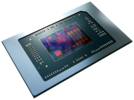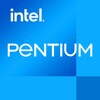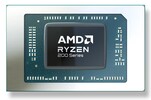AMD Ryzen 5 8645HS vs Intel Pentium 8505 vs AMD Ryzen 7 260
AMD Ryzen 5 8645HS
► remove from comparison
The Ryzen 5 8645HS is an upper mid-range processor (APU) of the Hawk Point family. This isn't an entirely new chip; instead, the 8645HS is a rebadged Ryzen 5 7640HS with higher clock speeds on the Ryzen AI NPU. The 8645HS was brought to life in Q4 2023 and it has 6 SMT-enabled Zen 4 cores (12 threads) running at 4.3 GHz to 5.0 GHz. The Radeon 760M iGPU is responsible for carrying out 3D calculations and similar duties.
Architecture & Features
Hawk Point family chips are powered by the Zen 4 architecture, much like Phoenix and Dragon Range family chips are. That's not to say there is no difference between the three. With Hawk Point, AMD is betting big on generative AI; these chips are promised to deliver an up to 40% increase in generative AI performance over 7040 series APUs making apps like DaVinci Resolve and Adobe Photoshop even more powerful.
Unlike Zen 3, Zen 4 features AVX512 support and, thanks to a plethora of other improvements including larger caches/registers/buffers across the board, is slated to bring a double-digit IPC improvement over the former.
Elsewhere, the 8645HS has 16 MB of L3 cache and a super-fast DDR5-5600 / LPDDR5x-7500 RAM controller. USB 4 (and thus Thunderbolt) is supported natively and so is PCIe 4. In fact, 20 PCIe 4 lanes are on offer; data transfer speeds of up to 7.8 GB/s will be possible provided a sufficiently fast NVMe SSD is used.
Systems powered by this Ryzen 5 series chip are expected to run 64-bit Windows 11, 64-bit Windows 10, or Linux. Please note that the APU is not overclockable and neither will you be able to replace it with a faster one as it gets soldered to the motherboard permanently (FP7, FP7r2, FP8 socket interfaces).
Performance
Since the 8645HX is an 7640HS in disguise, it is safe to expect the APU to be about as fast as the Ryzen 9 5900HX, Ryzen 7 6800H, Ryzen 7 7736U and also the Core i5-12500H, as far as multi-thread performance is concerned.
Your mileage may vary depending on how high the CPU power limits are and how competent the cooling solution of your system is.
Graphics
The Radeon 760M has 8 CUs (512 shaders) running at up to 2,600 MHz. While this is not the best graphics adapter for gaming as it's only just fast enough for low quality settings and resolutions such as 1600 x 900, it will let you connect up to four SUHD 4320p monitors and it also HW-encodes and HW-decodes the most widely used video codecs such as AV1, HEVC and AVC without breaking a sweat.
Power consumption
The 8645HS has a long-term power limit (default TDP) of 35 W to 54 W, giving laptop makers a choice between improving battery life and giving the system they are working on more oomph. Either way, an active cooling solution is a must for any system powered by the chip.
This Ryzen 5 series APU is built with TSMC's 4 nm process for high, as of late 2023, energy efficiency.
Intel Pentium 8505
► remove from comparison
The Intel Pentium 8505 is an entry-level mobile CPU for thin and light laptops based on the Alder Lake architecture. It was announced in early 2022 and offers one performance core (P-cores, Golden Cove architecture) and 4 efficient cores (E-cores, Gracemont architecture). The P-cores support Hyper-Threading leading to 6 supported threads when combined with the E-cores. The clock rate ranges from 1.2 to 4.4 GHz on the performance cluster and 0.9 to 3.3 GHz on the efficient cluster. The performance of the E-cores should be similar to old Skylake cores (compare to the Core i7-6700HQ). All cores can use up to 8 MB L3-cache. Compared to the faster Core i3-1215U, the Pentium offers one less P-core.
Performance
This is a fairly unpopular CPU, if the fact that we have not tested a single system built around it as of August 2023 is any indication. That said, we have tested a few systems featuring the Core i3-1215U, a chip with the same clock speeds and the same 4 E-cores but with 2 P-cores instead of 1. Based on that, expect the 8505 to be 10% to 20% behind the Ryzen 3 5300U and the Core i7-1185G7, as far as multi-thread benchmark scores are concerned.
Your mileage may vary depending on how competent the cooling solution of your laptop is and how high the CPU power limits are.
Features
The integrated memory controller supports various memory types up to DDR5-4800, DDR4-3200, LPDDR5-5200, and LPDDR4x-4267. The Thread Director (in hardware) can support the operating system to decide which thread to use on the performance or efficient cores for the best performance. For AI tasks, the CPU also integrates GNA 3.0 and DL Boost (via AVX2). Quick Sync in version 8 is the same as in the Rocket Lake CPUs and supports MPEG-2, AVC, VC-1 decode, JPEG, VP8 decode, VP9, HEVC, and AV1 decode in hardware. The CPU only supports PCIe 4.0 (x8 for a GPU and two x4 for SSDs).
The integrated graphics adapter is based on the Xe-architecture and offers 48 of the 96 EUs (Execution Units) operating at up to 1.1 GHz.
Power consumption
The Pentium has a Base power consumption of 15 W, with 55 W being its maximum Intel-recommended Turbo power consumption. These values are fairly high; passive cooling solutions aren't really an option here.
The CPU is built with Intel's 3rd generation 10 nm process marketed as Intel 7 for decent, as of early 2023, energy efficiency.
AMD Ryzen 7 260
► remove from comparison
The Ryzen 7 260 is a fast Hawk Point family chip for laptops that was announced at CES 2025. It features 8 Zen 4 cores (16 threads thanks to SMT support) running at up to 5.1 GHz. The chip is identical to the old Ryzen 7 8845HS and therefore also the Ryzen 7 7840HS (which did have a lower clocked NPU).
Architecture and Features
Hawk Point family chips are powered by the Zen 4 architecture, much like Phoenix and Dragon Range family chips were. The 16 TOPS NPU present here isn't powerful enough for systems built around the 260 to be Copilot+ certified.
Elsewhere, the Ryzen 7 has 16 MB of L3 cache and a seriously fast RAM controller (up to LPDDR5x-7500 and up to DDR5-5600). PCI-Express speeds are capped at 1.97 GB/s per lane which corresponds to the 4.0 spec.
Please note that the APU isn't overclockable and neither is it user-replaceable. It gets soldered to the motherboard for good instead (FP8 socket interfaces).
Performance
Since the R7 260 is an 8845HS / 7840HS in disguise, it's safe to expect it to be just slightly faster than the Core i9-13900H and also the Ryzen 9 7940HS, as far as multi-thread performance is concerned.
Your mileage may vary depending on how high the CPU power limits are and how competent the cooling solution of your system is.
Graphics
The Radeon 780M (12 CUs / 768 shaders, up to 2,700 MHz) is capable of powering 4 monitors simultaneously with resolutions as high as SUHD 4320p. It will also have little issue hardware-encoding and hardware-decoding the most widely used video codecs (such as AV1, HEVC, AVC). As far as gaming is concerned, the thing will let you play most games at 1080p as long as you are fine with low of very low settings.
Your mileage may vary depending on how high the APU power limits are, how competent the cooling solution of your system is, how fast the RAM of your system is (there is no dedicated VRAM here).
Power consumption
This Ryzen 7 series chip has a long-term power limit (default TDP) of 35 W to 54 W, giving system makers a choice between improving battery life and making the system they're designing as powerful as possible. Either way, an active cooling solution is a must for a laptop or a mini-PC built around this Ryzen.
The R7 260 is built with a 4 nm TSMC process for high, as of late 2023, energy efficiency.
| Model | AMD Ryzen 5 8645HS | Intel Pentium 8505 | AMD Ryzen 7 260 | ||||||||||||||||||||||||||||||||||||||||||||||||||||||||||||||||||||||||||||||||||||||||||||||||||||||||||||||||||||||||||||||||||||||||||||||||||||||||||||||||||||||||
| Codename | Hawk Point-HS (Zen 4) | Alder Lake-U | Hawk Point-HS (Zen 4) | ||||||||||||||||||||||||||||||||||||||||||||||||||||||||||||||||||||||||||||||||||||||||||||||||||||||||||||||||||||||||||||||||||||||||||||||||||||||||||||||||||||||||
| Series | AMD Hawk Point (Zen 4/4c) | Intel Alder Lake-M | AMD Hawk Point (Zen 4/4c) | ||||||||||||||||||||||||||||||||||||||||||||||||||||||||||||||||||||||||||||||||||||||||||||||||||||||||||||||||||||||||||||||||||||||||||||||||||||||||||||||||||||||||
| Series: Hawk Point (Zen 4/4c) Hawk Point-HS (Zen 4) |
|
|
| ||||||||||||||||||||||||||||||||||||||||||||||||||||||||||||||||||||||||||||||||||||||||||||||||||||||||||||||||||||||||||||||||||||||||||||||||||||||||||||||||||||||||
| Clock | 4300 - 5000 MHz | 900 - 4400 MHz | 3800 - 5100 MHz | ||||||||||||||||||||||||||||||||||||||||||||||||||||||||||||||||||||||||||||||||||||||||||||||||||||||||||||||||||||||||||||||||||||||||||||||||||||||||||||||||||||||||
| L1 Cache | 384 KB | 464 KB | 512 KB | ||||||||||||||||||||||||||||||||||||||||||||||||||||||||||||||||||||||||||||||||||||||||||||||||||||||||||||||||||||||||||||||||||||||||||||||||||||||||||||||||||||||||
| L2 Cache | 6 MB | 3.5 MB | 8 MB | ||||||||||||||||||||||||||||||||||||||||||||||||||||||||||||||||||||||||||||||||||||||||||||||||||||||||||||||||||||||||||||||||||||||||||||||||||||||||||||||||||||||||
| L3 Cache | 16 MB | 8 MB | 16 MB | ||||||||||||||||||||||||||||||||||||||||||||||||||||||||||||||||||||||||||||||||||||||||||||||||||||||||||||||||||||||||||||||||||||||||||||||||||||||||||||||||||||||||
| Cores / Threads | 6 / 12 6 x 5.0 GHz AMD Zen 4 | 5 / 6 | 8 / 16 8 x 5.1 GHz AMD Zen 4 | ||||||||||||||||||||||||||||||||||||||||||||||||||||||||||||||||||||||||||||||||||||||||||||||||||||||||||||||||||||||||||||||||||||||||||||||||||||||||||||||||||||||||
| TDP | 45 Watt | 15 Watt | 45 Watt | ||||||||||||||||||||||||||||||||||||||||||||||||||||||||||||||||||||||||||||||||||||||||||||||||||||||||||||||||||||||||||||||||||||||||||||||||||||||||||||||||||||||||
| Technology | 4 nm | 10 nm | 4 nm | ||||||||||||||||||||||||||||||||||||||||||||||||||||||||||||||||||||||||||||||||||||||||||||||||||||||||||||||||||||||||||||||||||||||||||||||||||||||||||||||||||||||||
| Die Size | 178 mm2 | 178 mm2 | |||||||||||||||||||||||||||||||||||||||||||||||||||||||||||||||||||||||||||||||||||||||||||||||||||||||||||||||||||||||||||||||||||||||||||||||||||||||||||||||||||||||||
| max. Temp. | 100 °C | 100 °C | 100 °C | ||||||||||||||||||||||||||||||||||||||||||||||||||||||||||||||||||||||||||||||||||||||||||||||||||||||||||||||||||||||||||||||||||||||||||||||||||||||||||||||||||||||||
| Socket | FP7/FP7r2/FP8 | BGA1744 | FP8 | ||||||||||||||||||||||||||||||||||||||||||||||||||||||||||||||||||||||||||||||||||||||||||||||||||||||||||||||||||||||||||||||||||||||||||||||||||||||||||||||||||||||||
| Features | DDR5-5600/LPDDR5x-7500 RAM, PCIe 4, Ryzen AI, AES, AVX, AVX2, AVX512, FMA3, MMX (+), SHA, SSE, SSE2, SSE3, SSE4.1, SSE4.2, SSE4A, SSSE3 | DDR4-3200/LPDDR4x-4266/DDR5-4800/LPDDR5-5200 RAM, PCIe 4, Thr. Director, DL Boost, GNA, MMX, SSE, SSE2, SSE3, SSSE3, SSE4.1, SSE4.2, AES, AVX, AVX2, FMA3, SHA | DDR5-5600/LPDDR5x-7500 RAM, PCIe 4, USB 4, Ryzen AI (16 TOPS), MMX, SSE, SSE2, SSE3, SSSE3, SSE4A, SSE4.1, SSE4.2, AVX, AVX2, AVX-512, BMI2, ABM, FMA, ADX, SMEP, SMAP, SMT, CPB, AES-NI, RDRAND, RDSEED, SHA, SME | ||||||||||||||||||||||||||||||||||||||||||||||||||||||||||||||||||||||||||||||||||||||||||||||||||||||||||||||||||||||||||||||||||||||||||||||||||||||||||||||||||||||||
| iGPU | AMD Radeon 760M ( - 2600 MHz) | Intel UHD Graphics Xe G4 48EUs ( - 1100 MHz) | AMD Radeon 780M ( - 2700 MHz) | ||||||||||||||||||||||||||||||||||||||||||||||||||||||||||||||||||||||||||||||||||||||||||||||||||||||||||||||||||||||||||||||||||||||||||||||||||||||||||||||||||||||||
| NPU / AI | 16 TOPS INT8 | 16 TOPS INT8 | |||||||||||||||||||||||||||||||||||||||||||||||||||||||||||||||||||||||||||||||||||||||||||||||||||||||||||||||||||||||||||||||||||||||||||||||||||||||||||||||||||||||||
| Chip AI | 31 TOPS INT8 | 38 TOPS INT8 | |||||||||||||||||||||||||||||||||||||||||||||||||||||||||||||||||||||||||||||||||||||||||||||||||||||||||||||||||||||||||||||||||||||||||||||||||||||||||||||||||||||||||
| Architecture | x86 | x86 | x86 | ||||||||||||||||||||||||||||||||||||||||||||||||||||||||||||||||||||||||||||||||||||||||||||||||||||||||||||||||||||||||||||||||||||||||||||||||||||||||||||||||||||||||
| Announced | |||||||||||||||||||||||||||||||||||||||||||||||||||||||||||||||||||||||||||||||||||||||||||||||||||||||||||||||||||||||||||||||||||||||||||||||||||||||||||||||||||||||||||
| Manufacturer | www.amd.com | ark.intel.com | www.amd.com |
Benchmarks
Average Benchmarks AMD Ryzen 5 8645HS → 100% n=2
Average Benchmarks Intel Pentium 8505 → 73% n=2
Average Benchmarks AMD Ryzen 7 260 → 113% n=2
* Smaller numbers mean a higher performance
1 This benchmark is not used for the average calculation













